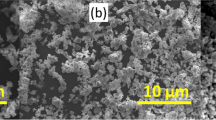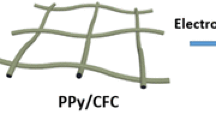Abstract
Electrochemical water splitting could be a potentially viable technique for obtaining the energy from renewable sources. The considerable overpotential demanded for sluggish oxygen evolution reaction (OER), however, prevents broad adoption of this approach. Herein, CoFe2O4/PPY hybrid is synthesized with a polypyrrole layered on the top of the CoFe2O4 via facile hydrothermal treatment. CoFe2O4/PPY is a highly efficient electrocatalyst, because it outperforms than pure CoFe2O4, PPY in terms of OER. CoFe2O4/PPY OER activities are comparable to those of commercial electrocatalysts. It's worth noting that the CoFe2O4/PPY hybrid is significantly more stable than the individuals, due to surface coated with PPY, responsible for good conduction of fast-moving electrons. The CoFe2O4/PPY coupling increases the OER by promoting electron exchange between the PPY layer and the CoFe2O4 reducing the over potential of (274 mV) and also lower the Tafel slope (47 mV/dec) with lower charge transfer resistance (3.15 Ω). According to the findings, on the top of CoFe2O4, a layer of PPY is applied for the surface modification using a conducting polymer can improve spinel oxides activity for future applications such as photoelectrocatalytic study, for stabilizing the material activity, etc.





Similar content being viewed by others
Data availability
Data sharing is not applicable to this article as no data sets were generated during the present study.
References
J. Xu et al., Platinum single atoms supported on nanoarray-structured nitrogen-doped graphite foil with enhanced catalytic performance for hydrogen evolution reaction. ACS Appl. Mater. Interfaces. 12(34), 38106–38112 (2020)
Z.W. Seh et al., Combining theory and experiment in electrocatalysis: Insights into materials design. Science (2017). https://doi.org/10.1126/science.aad4998
J. Hou et al., Rational design of nanoarray architectures for electrocatalytic water splitting. Adv. Func. Mater. 29(20), 1808367 (2019)
M.Y. ur Rehman et al., Facile synthesis of novel carbon dots@ metal organic framework composite for remarkable and highly sustained oxygen evolution reaction. J. Alloys Compds. 856, 158038 (2021)
M. Sadaqat et al., Iron doped nickel ditelluride hierarchical nanoflakes arrays directly grown on nickel foam as robust electrodes for oxygen evolution reaction. Electrochim. Acta 371, 137830 (2021)
Y. Huang et al., Mesoporous cobalt ferrite phosphides/reduced graphene oxide as highly effective electrocatalyst for overall water splitting. J. Colloid Interface Sci. 605, 667–673 (2022)
L. Fu et al., Facile fabrication of exsolved nanoparticle-decorated hollow ferrite fibers as active electrocatalyst for oxygen evolution reaction. Chem. Eng. J. 418, 129422 (2021)
I. Hamdani, A. Bhaskarwar, Recent progress in material selection and device designs for photoelectrochemical water-splitting. Renew. Sustain. Energy Rev. 138, 110503 (2021)
Z. Cao et al., Visualization of bubble dynamic behaviors during photoelectrochemical water splitting with TiO2 photoelectrode. Electrochim. Acta 347, 136230 (2020)
N. Nazar et al., Metal-organic framework derived CeO2/C nanorod arrays directly grown on nickel foam as a highly efficient electrocatalyst for OER. Fuel 307, 121823 (2022)
J. Wang et al., Recent progress in cobalt-based heterogeneous catalysts for electrochemical water splitting. Adv. Mater. 28(2), 215–230 (2016)
P. Millet et al., PEM water electrolyzers: From electrocatalysis to stack development. Int. J. Hydrogen Energy 35(10), 5043–5052 (2010)
G.E. Blomgren, The development and future of lithium ion batteries. J. Electrochem. Soc. 164(1), A5019 (2016)
E. Frackowiak, Carbon materials for supercapacitor application. Phys. Chem. Chem. Phys. 9(15), 1774–1785 (2007)
D.M. Bierschenk, J.R. Wilson, S.A. Barnett, High efficiency electrical energy storage using a methane–oxygen solid oxide cell. Energy Environ. Sci. 4(3), 944–951 (2011)
F.A. Garcés-Pineda et al., Direct magnetic enhancement of electrocatalytic water oxidation in alkaline media. Nat. Energy 4(6), 519–525 (2019)
S. Li et al., A glass-ceramic with accelerated surface reconstruction toward the efficient oxygen evolution reaction. Angew. Chem. Int. Ed. 60(7), 3773–3780 (2021)
D. Zhou et al., Layered double hydroxide-based electrocatalysts for the oxygen evolution reaction: identification and tailoring of active sites, and superaerophobic nanoarray electrode assembly. Chem. Soc. Rev. 50, 8790 (2021)
W.-H. Huang et al., Highly efficient electrocatalysts for overall water splitting: mesoporous CoS/MoS 2 with hetero-interfaces. Chem. Commun. 57(39), 4847–4850 (2021)
F. Song et al., Transition metal oxides as electrocatalysts for the oxygen evolution reaction in alkaline solutions: an application-inspired renaissance. J. Am. Chem. Soc. 140(25), 7748–7759 (2018)
W.-H. Huang et al., CoMo-bimetallic N-doped porous carbon materials embedded with highly dispersed Pt nanoparticles as pH-universal hydrogen evolution reaction electrocatalysts. Nanoscale 12(38), 19804–19813 (2020)
C. Wei et al., Recommended practices and benchmark activity for hydrogen and oxygen electrocatalysis in water splitting and fuel cells. Adv. Mater. 31(31), 1806296 (2019)
M. Sadaqat et al., Zinc-telluride nanospheres as an efficient water oxidation electrocatalyst displaying a low overpotential for oxygen evolution. J. Mater. Chem. A 7(46), 26410–26420 (2019)
H. Liu et al., PEDOT decorated CoNi2S4 nanosheets electrode as bifunctional electrocatalyst for enhanced electrocatalysis. Chem. Eng. J. 428, 131183 (2022)
H. Yin et al., Remarkably enhanced water splitting activity of nickel foam due to simple immersion in a ferric nitrate solution. Nano Res. 11(8), 3959–3971 (2018)
A.G. Abid et al., Scalable synthesis of Sm2O3/Fe2O3 hierarchical oxygen vacancy-based gyroid-inspired morphology: with enhanced electrocatalytic activity for oxygen evolution performance. Energy Fuels 35(21), 17820–17832 (2021)
T. Tian et al., Study of the active sites in porous nickel oxide nanosheets by manganese modulation for enhanced oxygen evolution catalysis. ACS Energy Lett. 3(9), 2150–2158 (2018)
Q. Zhou et al., Active-site-enriched iron-doped nickel/cobalt hydroxide nanosheets for enhanced oxygen evolution reaction. ACS Catal. 8(6), 5382–5390 (2018)
C.L.I. Flores, M.D.L. Balela, Electrocatalytic oxygen evolution reaction of hierarchical micro/nanostructured mixed transition cobalt oxide in alkaline medium. J. Solid State Electrochem. 24(4), 891–904 (2020)
J. Qi et al., Porous nickel–iron oxide as a highly efficient electrocatalyst for oxygen evolution reaction. Adv. Sci. 2(10), 1500199 (2015)
T. Saravanakumar et al., Hexacyanoferrate-complex-derived NiFe2O4/CoFe2O4 heterostructure–MWCNTs for an efficient oxygen evolution reaction. Energy Fuels 35(6), 5372–5382 (2021)
S. Ye et al., Deeply self-reconstructing CoFe(H3O)(PO4)2 to low-crystalline Fe0.5Co0.5OOH with Fe3+–O–Fe3+ motifs for oxygen evolution reaction. Appl. Catal. B 304, 120986 (2021)
J. Liu et al., Amorphous FeOOH coating stabilizes WO2-NaxWO3 for accelerating oxygen evolution reaction. Chem. Eng. J. 426, 131253 (2021)
L. Lv et al., 2D layered double hydroxides for oxygen evolution reaction: from fundamental design to application. Adv. Energy Mater. 9(17), 1803358 (2019)
R.D. Smith et al., Water oxidation catalysis: electrocatalytic response to metal stoichiometry in amorphous metal oxide films containing iron, cobalt, and nickel. J. Am. Chem. Soc. 135(31), 11580–11586 (2013)
L. Gong et al., Enhanced catalysis of the electrochemical oxygen evolution reaction by iron (III) ions adsorbed on amorphous cobalt oxide. ACS Catal. 8(2), 807–814 (2018)
N.A. Frey et al., Magnetic nanoparticles: synthesis, functionalization, and applications in bioimaging and magnetic energy storage. Chem. Soc. Rev. 38(9), 2532–2542 (2009)
N. Moumen, M. Pileni, Control of the size of cobalt ferrite magnetic fluid. J. Phys. Chem. 100(5), 1867–1873 (1996)
H.M. Joshi et al., Effects of shape and size of cobalt ferrite nanostructures on their MRI contrast and thermal activation. J. Phys. Chem. C 113(41), 17761–17767 (2009)
Y. Oh et al., Magnetic hyperthermia and pH-responsive effective drug delivery to the sub-cellular level of human breast cancer cells by modified CoFe2O4 nanoparticles. Biochimie 133, 7–19 (2017)
Y. Kumar, A. Sharma, P.M. Shirage, Shape-controlled CoFe2O4 nanoparticles as an excellent material for humidity sensing. RSC Adv. 7(88), 55778–55785 (2017)
M.P. Browne et al., Improving the performance of porous nickel foam for water oxidation using hydrothermally prepared Ni and Fe metal oxides. Sustain. Energy Fuels 1(1), 207–216 (2017)
K. Haas-Santo, M. Fichtner, K. Schubert, Preparation of microstructure compatible porous supports by sol–gel synthesis for catalyst coatings. Appl. Catal. A 220(1–2), 79–92 (2001)
J. Huang et al., Improving electrocatalysts for oxygen evolution using NixFe3–xO4/Ni hybrid nanostructures formed by solvothermal synthesis. ACS Energy Lett. 3(7), 1698–1707 (2018)
Z. Wang et al., A facile co-precipitation synthesis of robust FeCo phosphate electrocatalysts for efficient oxygen evolution. Electrochim. Acta 264, 244–250 (2018)
J.G.D. Haenen, W. Visscher, E. Barendrecht, Oxygen evolution on NiCo2O4 electrodes. J. Appl. Electrochem. 15(1), 29–38 (1985)
H. Yuan et al., Oxygen vacancies engineered self-supported B doped Co3O4 nanowires as an efficient multifunctional catalyst for electrochemical water splitting and hydrolysis of sodium borohydride. Chem. Eng. J. 404, 126474 (2021)
V. Khomenko, E. Frackowiak, F. Beguin, Determination of the specific capacitance of conducting polymer/nanotubes composite electrodes using different cell configurations. Electrochim. Acta 50(12), 2499–2506 (2005)
M. Alsultan et al., Conducting-polymer nanocomposites as synergistic supports that accelerate electro-catalysis: PEDOT/Nano Co3O4/rGO as a photo catalyst of oxygen production from water. J. Compos. Sci. 5(9), 245 (2021)
P. Zhang et al., Self-assembly formation of hierarchical mixed spinel MnCo2O4 porous nanospheres confined by polypyrrole pyrolytic carbon for high-performance lithium storage. Mater. Today Energy 17, 100451 (2020)
Y. Liu et al., Preparation of PPy/TiO2 core-shell nanorods film and its photocathodic protection for 304 stainless steel under visible light. Mater. Res. Bull. 124, 110751 (2020)
H.N. Cong, K. El Abbassi, P. Chartier, Electrically conductive polymer/metal oxide composite electrodes for oxygen reduction. Electrochem. Solid State Lett. 3(4), 192 (2000)
B. Chaluvaraju, S.K. Ganiger, M. Murugendrappa, Synthesis, characterization and DC conductivity studies of polypyrrole/tantalum pentoxide composites. Int. J. Latest Technol. Eng. 3(5), 33–36 (2014)
M. Safari, J. Mazloom, Electrochemical performance of spindle-like Fe2Co-MOF and derived magnetic yolk-shell CoFe2O4 microspheres for supercapacitor applications. J. Solid State Electrochem. 25, 2189–2200 (2021)
S. Manzoor et al., Development of excellent and novel flowery zirconia/cadmium sulfide nanohybrid electrode: For high performance electrochemical supercapacitor application. J. Energy Storage 40, 102718 (2021)
Acknowledgements
We would like to thank Taif University Research Supporting Project number (TURSP-2020/63), Taif University, Taif, Saudi Arabia. This work was also supported by King Khalid University through a grant (RCAMS/KKU/G001/21) under the Research Center for Advanced Materials Science (RCAMS) at King Khalid University, Saudi Arabia.
Author information
Authors and Affiliations
Contributions
SA, MH, SM, NA: Worked in the laboratory, i.e., experimental work done and also wrote the manuscript, development or design of methodology; creation of models. MSAB, SA: Visualization. SRE, RYK, ZAA: Writing, review and editing. HHS: Supervision.
Corresponding author
Ethics declarations
Conflict of interest
No potential conflict of interest was reported by the author.
Additional information
Publisher's Note
Springer Nature remains neutral with regard to jurisdictional claims in published maps and institutional affiliations.
Rights and permissions
About this article
Cite this article
Alwadai, N., Manzoor, S., Ejaz, S.R. et al. CoFe2O4 surface modification with conducting polypyrrole: employed as a highly active electrocatalyst for oxygen evolution reaction. J Mater Sci: Mater Electron 33, 13244–13254 (2022). https://doi.org/10.1007/s10854-022-08265-y
Received:
Accepted:
Published:
Issue Date:
DOI: https://doi.org/10.1007/s10854-022-08265-y




